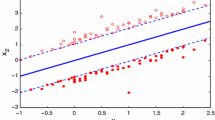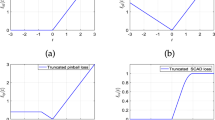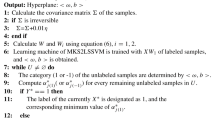Abstract
Semi-supervised classification methods are widely-used and attractive for dealing with both labeled and unlabeled data in real-world problems. In this paper, a novel kernel-free Laplacian twin support vector machine method is proposed for semi-supervised classification. Its main idea is to classify data points into two classes by constructing two nonparallel quadratic surfaces so that each surface is close to one class of points and far away from the other class of points. The proposed method not only saves much computational time by avoiding choosing a kernel function and its related parameters in the classical support vector machine, but also addresses the issue of computational complexity by adopting manifold regularization technique. Moreover, two small-sized convex quadratic programming problems need to be solved to implement the proposed method, which is much easier than solving the non-convex problem of mixed integer programming to implement the well-known semi-supervised support vector machine. Finally, the numerical results on some artificial and benchmark data sets validate the competitive performance of proposed method in terms of efficiency, classification accuracy and generalization ability, by comparing to well-known semi-supervised methods. In particular, the proposed method handles five benchmarking disease diagnosis problems well and efficiently, which indicates the potential of proposed method in diagnosing and forecasting the diseases.

Similar content being viewed by others
References
Astorino A, Fuduli A (2007) Nonsmooth optimization techniques for semisupervised classification. IEEE Trans Pattern Anal 29(12):2135–2142
Astorino A, Fuduli A (2015a) Semisupervised spherical separation. Appl Math Model 39(20):6351–6358
Astorino A, Fuduli A (2015b) Support vector machine polyhedral separability in semisupervised learning. J Optim Theory Appl 164(3):1039–1050
Bai Y, Yan X (2016) Conic relaxation for semi-supervised support vector machines. J Optim Theory Appl 169(1):299–313
Bai Y, Han X, Chen T, Yu H (2015) Quadratic kernel-free least squares support vector machine for target diseases classification. J Comb Optim 30(4):850–870
Belkin M, Niyogi P, Sindhwani V (2006) Manifold regularization: a geometric framework for learning from labeled and unlabeled examples. J Mach Learn Res 7:2399–2434
Chapelle O, Sindhwani V, Keerthi SS (2008) Optimization techniques for semi-supervised support vector machines. J Mach Learn Res 9:203–233
Chen WJ, Shao YH, Hong N (2014) Laplacian smooth twin support vector machine for semi-supervised classification. Int J Mach Learn Cybern 5(3):459–468
Chen X, Fan Z, Li Z, Han X, Zhang X, Jia H (2015) A two-stage method for member selection of emergency medical service. J Comb Optim 30(4):871–891
Collobert R, Sinz F, Weston J, Bottou L (2006) Large scale transductive SVMs. J Mach Learn Res 7:1687–1712
Dagher I (2008) Quadratic kernel-free non-linear support vector machine. J Global Optim 41(1):15–30
Deng N, Tian Y, Zhang C (2012) Support vector machines-optimization based theory, algorithms and extensions. CRC Press, Boca Raton
Gao W, Bao W, Zhou X (2019) Analysis of cough detection index based on decision tree and support vector machine. J Comb Optim 37(1):375–384
Gao Z, Yang L (2019) Energy-saving operation approaches for urban railtransit systems. Front Eng 6(2):139–151
Jayadeva Khemchandani R, Chandra S (2007) Twin support vector machines for pattern classification. IEEE Trans Pattern Anal Mach Intell 29(5):905–910
Joachims T (1999) Transductive inference for text classification using support vector machines. In: Proceedings of the 16th international conference on machine learning, pp 200–209
Luo J, Fang SC, Deng Z, Guo X (2016) Soft quadratic surface support vector machine for binary classification. Asia Pac J Oper Res 33(6):1650046
Luo J, Hong T, Fang SC (2018) Benchmarking robustness of load forecasting models under data integrity attacks. Int J Forecast 34(1):89–104
Melacci S, Belkin M (2011) Laplacian support vector machines trained in the primal. J Mach Learn Res 12:1149–1184
Niu D, Ma T, Liu B (2017) Power load forecasting by wavelet least squares support vector machine with improved fruit fly optimization algorithm. J Comb Optim 33(3):1122–1143
Qi Z, Tian Y, Shi Y (2012) Laplacian twin support vector machine for semi-supervised classification. Neural Netw 35:46–53
Shao YH, Zhang CH, Wang XB, Deng NY (2011) Improvements on twin support vector machines. IEEE Trans Neural Netw 22(6):962–968
Tian Y, Qi Z, Ju X, Shi Y, Liu X (2014) Nonparallel support vector machines for pattern classification. IEEE Trans Cyber 44(7):1067–1079
Tian Y, Sun M, Deng Z, Luo J, Li Y (2017) A new fuzzy set and non-kernel svm approach for mislabeled binary classification with applications. IEEE Trans Fuzzy Syst 25(6):1536–1545
Yan X, Bai Y, Fang SC, Luo J (2018) A proximal quadratic surface support vector machine for semi-supervised binary classification. Soft Comput 22(20):6905–6919
Acknowledgements
This research has been supported by MOE (Ministry of Education in China) Youth Foundation of Humanities and Social Sciences (No. 18YJC630220), the National Natural Science Foundation of China (Nos. 71901140, 71701035 and 71831003), Project of Philosophy and Social Science Planning in Shanghai (No. 2018EGL016).
Author information
Authors and Affiliations
Corresponding author
Additional information
Publisher's Note
Springer Nature remains neutral with regard to jurisdictional claims in published maps and institutional affiliations.
Rights and permissions
About this article
Cite this article
Yan, X., Zhu, H. & Luo, J. A novel kernel-free nonlinear SVM for semi-supervised classification in disease diagnosis. J Comb Optim 42, 948–965 (2021). https://doi.org/10.1007/s10878-019-00484-0
Published:
Issue Date:
DOI: https://doi.org/10.1007/s10878-019-00484-0




